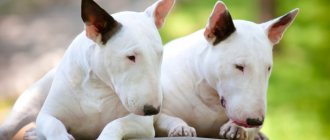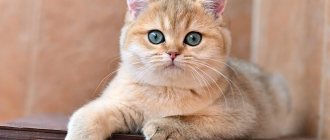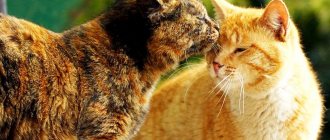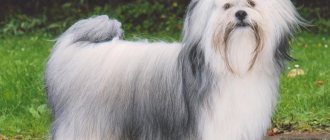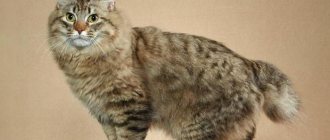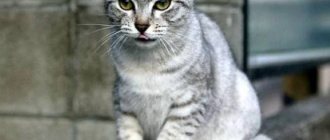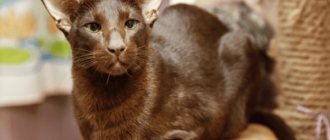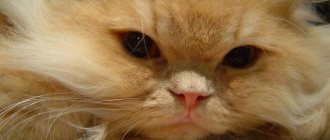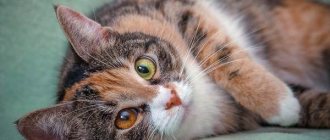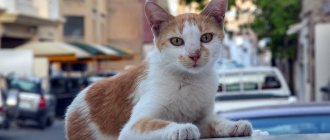The British are no strangers to aristocratic manners and self-sufficiency. Without any advertising or made-up stories, the British cat is truly popular. Worldly vanity is not for them. These cozy, important, personable, stocky cats are especially loved by respectable men, perhaps due to some similarities.
British cats look like women from high society: beautiful and inaccessible. They will not take well to intrusiveness from guests and even the owner. They perfectly express their love for their owner, while being at a distance from him. Therefore, you don’t have to worry that he will get very bored at home alone; most likely, he will even have a great rest without your presence.
British cat - plush joy
Description of the breed
The British Shorthair is a cat breed that was first registered in 1898. It is the result of selection of the Persian breed and the ancestors of wild cats, transported from France by settlers several centuries ago. These are wayward and independent animals, with the nature of an aristocrat, who will not contact strangers.
After several generations, the British Longhair appeared, which in June 1979 was registered by the international organization TICA. Today, the breed has already been recognized by many organizations and its representatives boldly exhibit at various exhibitions and receive awards, recognition, and popularity. These two breeds are similar to each other not only in character, but also in body structure.
Britons are loyal, loving animals who bond well with children, making them suitable for families with small children. They are playful, but not affectionate. If the family is large, they do not choose one person for friendship, but establish friendly relations with all members of the household.
This is a companion breed, but at the same time it should have time and personal space for privacy. They don’t like being picked up or kissed, so they will resist this in every possible way, pushing and turning away.
History of the origin of British Shorthair cats
Representatives of felinology still cannot agree on the origin of British cats.
Today there are two main versions, each of which has its own list of supporters:
- France. Many felinologists believe that the history of the British is closely connected with their fellow French - the Chartreuse cat breed. According to scientists, representatives of these groups were brought to Europe from Africa at approximately the same time. The new breed was first bred by monks. Cats came to Britain through ships, where they served as rat catchers. This theory is confirmed by the similarity between the British and the Chartreuse;
- Rome. Delving into history, you can find interesting facts about the conquest of Britain by Rome. It is with this event, according to felinology scientists, that the emergence of this breed on British soil is connected. Felinologists believe that the Romans brought Roman cats to Britain, which, in turn, quickly adapted to the new land and were loved by its settlers. This version of origin is confirmed by numerous mass graves of cats that were discovered by archaeologists in Britain.
Only one thing can be said with certainty: the real history of cats began in Britain. It is here that the earliest depictions of British Shorthairs were discovered, dating back to around the 700s. Small pictures of animals were applied to colored miniatures.
Interesting fact: There were images of representatives of this breed in books. So, in the 800s, in a handwritten book, one of the Irish monks drew a British shorthair cat and wrote that such an animal really brightens up the monastic everyday life, making them more interesting.
In the 10th century, the cult of the British only increased. At this time, the Celtic sculptor, when creating a stone cross with scenes from the Passion of Christ, did not forget to add cats. One had a small kitten in his paws, and the other had a chick. Around the same time, a law was passed in Britain to protect cats. Representatives of this breed were very expensive.
Exterior of a cat
British cats have a strong body: powerful short llamas, a thick tail, slightly rounded at the end. Another special characteristic of the breed is its dense, plush coat that does not lie close to the body with a fine structure, as well as a round muzzle with large cheeks, and large bright orange eyes. The paws are round and small. The ears are wide and low set, small, slightly rounded at the tips.
Thick fur with a delicate undercoat, when you stroke or caress it, you get the feeling that you are touching a plush toy. Medium-sized animals with a large body and roundish paws with pink-coffee pads. There may be tufts of wool between the toes, and fluffy woolen trousers and a rich collar at the back. The tail is short, but incredibly bushy - when a cat gets angry and starts waving it, it looks like a huge fan.
The long-haired British breed is of short stature, but with a long body. They have a massive chest, a short neck and a large head with wide cheekbones. If you look closely at the face, it seems that the cat is smiling. The ears are slightly rounded and set wide apart. Eyes can be of different colors: yellow, closer to orange, blue and green.
What is noteworthy is that both animals in a pair must have the same eye color; you cannot cross cats of green-eyed representatives of the breed with blue-eyed cats or a cat with orange eyes.
The pads with whiskers near the small nose give the breed a certain charm; the British have massive whiskers, and the whiskers are long and stick out in lush bushes in different directions. Very cute creatures - it’s impossible not to love them, they are just soft little cuties. The weight of an adult cat is 5-7 kilograms, slightly smaller cats weigh about 4-5 kilograms.
Breed colors
According to the standard, the breed can have several colors, each of them beautiful and unusual in its own way. Most have a single color color - white, ash-blue with a bluish tint, cream shades, chocolate. Black and red long-haired cats look impressive; this color is unusual for the British, but at the same time interesting, and the mystery always causes demand and popularity.
This breed also comes in tortoiseshell and marbled colors. Smoky cats resemble chinchillas, they are also called smokes, cameos. What makes them special is the fact that their undercoat is white - a very attractive combination. The legs, head and back are in darker colors, and the belly and fluffy collar are lighter, sometimes almost white.
The tabby color deserves special attention - smoky with stripes slightly darker in color from the base. The chest and neck have continuous rings, and on the forehead of such cats the letter “M” clearly appears - the dark color of the coat grows in this way. The legs and lush hips are covered with circles - this is a feature of British tabbys with semi-long hair.
This breed also has bicolors, which combine the main color with white. In this case, the standard stipulates that white should not be more than 30% and this is mainly the breasts, neck, and belly.
It is unacceptable to have lightened tips on the coat, like representatives of the Russian Blue cat. The heavily bleached blue color prevents her from receiving the title. Despite its impressiveness, black color is considered the most problematic, since the presence of white hairs or brown spots is unacceptable. Chocolate color is considered both beautiful and complex.
It is worth noting that the fur coat of these animals is very complex. It consists of a two-level structure: a dense undercoat and guard hairs protruding above it. This feature creates the famous pearlescent sheen for kittens with a lilac or blue color.
The world of British cats originally from England is rich and attractive. They are charmingly showy and graceful, as if emphasizing their aristocratic origin.
Popular colors of British Shorthair cats
Initially, almost all British cats had a gray-blue color (which is what their first name is associated with). During the selection process, the colors of the animals changed. Today, more than 100 types of British colors are known.
The most popular and frequently encountered of them are the following pattern options:
- Solid. In this case, the animal’s fur is completely painted in one specific color. Most often, the British have blue, gray-blue, black, silver, tabby shades;
- Smoky. This coloring is based on the contrast between the undercoat (as light as possible) and the coat itself (tips as dark as possible). The legs, back and head will be the darkest. The muzzle and legs themselves have practically no markings. This color is characterized by orange (copper) eyes;
- Bicolors. The coat of representatives of this color combines two shades: the main one (tortoiseshell/solid) and white. At the same time, the light part of the body is clearly separated from the dark part and has no hairs of any other shade (than white);
- Tortoiseshell. This color implies two or more shades that are similar to each other (blue and cream, red and black). Tortoiseshell coloring refers to the so-called spots on animal fur;
- Tabby. A color in which spots are clearly visible on the cat’s body: on the forehead in the shape of the letter “M”, on the back there are clear lines along the spine, on the chest there are continuous rings, the belly is spotted. This color is also called marbled, tacked, striped and spotted;
- Colorful. A color that implies the presence of a white “cloak” (on the body). With colorful coloring, only some parts of the body are actually colored: tail, paws, muzzle. An interesting fact is that this color can change due to temperature changes.
The presented classification is general. Due to selection, other shades can be obtained. However, only British dogs whose color is recognized and acceptable are allowed to take part in shows.
Character and behavior
According to breeders, a British cat, like Maine Coons, is an ideal addition to a cozy and calm home. The main condition for the breed to be in the house should be psychological comfort and tranquility in the family, and living conditions do not bother them too much. They will fit perfectly in a small apartment or in a huge mansion. They are not prone to aggression, will find a common language with dogs, and will become a child’s best friend.
The British are calm. even somewhat lazy cats. They love to sleep in a cozy place and easily become attached to their owner. Kittens are very inquisitive and incredibly playful - they love to run after a ball, climb on racks, and tumble with each other. If they are interested in something or are bored, they will find something to entertain themselves with. They can throw a piece of candy, a hairpin, a pen, or something else into their teeth with their paw, which they will then play with. Kittens are quite easy to toilet train as they are smart and clean creatures.
Adult cats are the embodiment of calm and peacefulness. They calmly tolerate the absence of their owners at home, in some cases they may not even notice, since they slept all day. But when they hear the steps of the owners who come home, they always greet them and rub against their feet, putting their muzzle up to be stroked. British cats get along well with children; there are cases when they try to lie next to or in the arms of special children, as if sensing their weakness and insecurity.
They get along with other animals in the house or try not to notice them. They are even very friendly with dogs and cats, they make contact with them or bully them, trying to involve them in the game. They are inquisitive creatures, easy to train, and understand the character of their owners. They don’t like excessive attention to them, being carried in your arms, or being squeezed - they’d rather lie on the sidelines, but you can pet them anyway.
Their meowing is similar to some kind of hoarse chirping and they pronounce these sounds muffled and not loud. Each jump from a height is accompanied by this sound - it looks fun and funny.
Features of the British
- They lend themselves well to training and education. These smart animals can follow directions and remember up to 50 words.
- Although they are distinguished by a certain stubbornness, they carry out the owner’s commands accurately. In order for him to fully reveal his character to you, you need to respect his personality and find time to communicate.
- They react perfectly to the appearance of a new animal in the family, without fights or jealousy. They are not characterized by impulsiveness or aggression. They get along well not only with cats, but also with dogs, if they are compatible with each other in character.
- The Briton will be a wonderful friend for a person who is constantly at work, since the lack of communication does not negatively affect the animal.
- These are not tame pets; they would rather lie down close to you, or curl up in a ball, rather than lie in your arms.
- They will never do anything they don’t like and will not accept the annoying affection of their owners.
- When they are small, kittens love affection and ask to be held, but when they grow up, they prefer to keep their distance from their owners. Tenderness and affection in their understanding are manifested in mutual respect and strong emotional contact.
- Although they get along well with children, they may be offended if the child is overly active, so they may try not to show themselves to the children too much.
Interesting facts about British Shorthair cats
British shorthair cats are already unusually amazing and fascinating in themselves. Therefore, it is not at all strange that there are many facts that only increase the interest of pets.
Here are a few as examples:
- British cats are independent from people (as they believe). They choose for themselves who will be their friend and who they will never let close to them;
- There are no lop-eared Britons. You can often find the name “British Fold”. It is completely false. Only Scots can have long-eared or straight-eared ears. The British come in short- and long-haired varieties;
- British Shorthairs do not require special care for their coat. The molting of these animals is less problematic than the molting of their close relatives;
- The British have their own opinion on any issue. They need to be raised from early childhood - otherwise the cat will really become the master of the house;
- Animals are not afraid of loneliness. They can remain alone with themselves even for several days. The main thing is to always have a filled bowl nearby;
- According to one version, the image of the Cheshire cat was copied specifically from representatives of the British breed;
- Britons are one of the most ancient cats on earth. Despite its already venerable age, the breed gained worldwide fame and popularity relatively recently;
- Representatives of the British Shorthair breed are true sleepyheads. For the British, the daily sleep norm is 14-16 hours;
- Nowadays, British Shorthairs mostly decorate homes. Previously, the main task of representatives of this breed was to fight rodents. Therefore, the British have very well developed hunting abilities.
And the final interesting fact about these amazing cats is that the British tabby cat is the official representative of the Whiskas brand!
Pros and cons of the breed
The character of the breed can be called universal; they can get along in any family. It is not difficult to care for them: play, feed them properly. They are a long-lived breed (they live up to 20 years), and always look young, perhaps because they mature only at 3 years.
Those wishing to acquire this breed of cat should remember that they will not lie on their owner’s lap for hours and demand affection. Quite the contrary, the British refuse to be cuddled, stroked or hugged.
It is also useless to train them, although some owners managed to get their pets to greet each other like dogs - the cat began to offer its paw.
British cats adapt both to indoor conditions and to living outdoors, for example, in the country. This breed is very active, so they should have enough space for games, various “climbing areas” so that the cat can jump and move around for pleasure.
Due to the fact that the ancestors of this breed are wild cats, they have excellent health and hunter habits, so they need to be outside as often as possible.
The period of sexual aggravation in the female is quite stormy, with meowing and mating games characteristic of many of their relatives. On average, a British woman gives birth to 4-7 kittens; cats have a well-developed maternal instinct. If a male lives with a cat in the same house, then he can equally take part in taking care of the babies - licking them, warming them with his warmth.
Habits
The bright character traits of the British directly influence their habits. Some people believe that since animals belonging to the presented breed are quite obedient, then they cannot do any bad things, but this is not so.
Common negative habits include:
- Scratching and biting hands.
- Throwing objects off surfaces.
To somehow compensate for this, many people want to know how the British are doing with catching mice, and this is a completely different matter.
Catching mice
British cats are often called clumsy. It is impossible to argue with this, but this does not prevent them from being excellent rat-catchers and mouse-catchers. If you believe history, the French always took cats of these breeds with them on voyages so that they would keep an eye on supplies and leave no chance for rodents to profit from various delicacies.
It is rare to find mice in modern apartments, so even with a strong desire, it would be difficult for cats to try to hunt someone. Another thing is animals that live in private sectors and in dachas. Pet owners have repeatedly noted that cats are very agile and excellent hunters. Some people believe that since they managed to cope with the rodent, they should definitely feast on it, but this is not so. Representatives of felines catch mice and rats for fun, they do not even understand that this is food that should be eaten. The reason lies in the character of the British cat, which was taught from childhood to a place for food. Having played enough, the animal leaves its prey and goes on about its business.
Biting and scratching
Scratching and biting the hands of their owners is a favorite activity of four-legged animals. At the age of three or four months, the kitten begins to bite the hands and sometimes the legs of a person. This is directly related to the change of teeth in animals. There is no need to think that such a habit will go away on its own. If the situation continues for a month, the animal will realize that it is possible to do this and in the future you will not wean it from it. At the same time, there is no need to try to beat the baby or shout at him; it is not his fault that his teeth itch. It needs to be done much simpler - during an attack, put a soft toy or mouse on your hand, which will interest the pet and become its favorite victim in the future.
Dropping items
Throwing objects off the table is an equally interesting activity. It can be anything, from a pen to a flower pot. Among the main character traits, self-indulgence is not listed among the British, but for them it is not self-indulgence, but curiosity. Cats are very interested to see how the object will fly down and what will happen to it after. If you want to stop this, then you should either sprinkle the surface with a pungent odor that animals cannot tolerate, or make the surface so that the pet does not have the slightest chance of climbing on it. At the same time, you must not forget about toys for your pet so that he does not have to get bored.
Care and maintenance of a British cat
Beautiful and thick hair is the wealth of British cats. Unlike Persians, their fur does not bunch up. To do this, it is enough to scratch them 1-2 times a week with a hard brush with rubber tips or a special mitten with teeth, which are available in every pet store or veterinary pharmacy.
During the molting period, you can carry out scratching procedures more often to help the cat renew its coat. This kind of care will help avoid having six throughout the house. Long-haired cats can also be cut or groomed. Modern pet salons offer a number of different services for cats; there is a catalog of hairstyles that can be done for cats and they will look attractive and well-groomed every time.
Since cats shed twice a year in autumn and spring, and their fur is very thick and the animals often lick themselves, it is advisable to give hair-removing drugs during this period. The procedure will help to gently remove hair from the cat’s body and avoid pain and clogging of the stomach and intestines.
Bathing is an activity that most felines dislike. If you are accustomed to the procedure from infancy, then in the future there will be no problems with bathing. You can wash the wool with a mild shampoo, but without fragrances and dyes, with a neutral pH. After the bath, wrap the cat in a soft towel and let the water soak in; do not try to rub, as this can lead to tangling of the fur.
Your pet’s claws also require careful care, as this breed is more susceptible to fungal diseases than others. The claws should not flake or peel, as this may be a signal of the presence of fungal diseases. It is enough to trim the nails once every 2 to 3 weeks. At least once every six months, the cat must be shown to the veterinarian.
With proper care, your furry pet will live up to 15-20 years, which is the average statistical life span for the British. Nature has given them a sharp mind, complaisance and equanimity - they calmly endure visits to the veterinarian, moving, and traveling.
British Shorthair cat - description of the breed
British shorthair cats are the most ancient representatives of large cats. The original name of the breed was “British Blue”. This is due to the peculiarity of the pet’s iridescent color. The new name is also associated with wool, only this time not with color, but with length: “Shorthair”.
The British are quite strong and robust pets, characterized by medium and large dimensions.
The main descriptive features of the body structure are:
- Round head, widened at the cheekbones. The neck of cats is very thick (almost invisible), but at the same time short;
- Expressive muzzle. The nose is short and straight. He is vertical with a strong chin;
- Big eyes. The look is one of the main characteristics of the British. The eyes of these cats are large, wide open and set far apart. They can be orange or blue. The shade of the eyes depends on the color of the animal;
- Squat body. The body of the animals is straight, the back is short, and the shoulders are massive;
- Short legs. At the same time, cats’ paws are very strong and large;
- Thick tail. This part of the cat's body is not very long. The tail is rounded at the end;
- Thick and short fur. The most important feature of animals of this breed. The British coat is shiny, medium soft/hard and has a dense texture.
In general, representatives of the British Shorthair look very attractive and graceful. It was their appearance that became the reason for the increased love for them from people. What attracts most about the British is their look and fluffy big cheeks, which children love to squeeze.
Average whole adult: 6-9 kg (males) and 4-6 kg (females). Height at the withers is 28-33 cm. The life expectancy of pets is 15-20 years. This period largely depends on the Briton’s habitat, conditions of detention, nutrition and treatment. Animals need regular vaccinations and a special menu. Moreover, they can be kept both indoors and outdoors.
Proper nutrition and menu for the British
British breed cats are massive, heavy individuals that require a special diet with a high protein content (up to 33 - 34%). In addition, their diet should contain a large amount of vitamins (biotin, calcium, microelements), possibly in the form of vitamin complexes (this way you will eliminate allergies). Representatives of this breed are not picky, so they can be fed both dry food and natural food, but under no circumstances mix these two food options.
To highlight the color of the animal, you can add vitamins with seaweed. After this, the red and tortoiseshell color will be brighter, the lilac color will receive a warmer, pink tone. Even the eyes will have a more intense color. If you give this supplement to cats of cream, blue-cream, or chinchilla color, the color will become darker. There are other foods that affect the color of an animal's fur: liver, carrots.
For example, a natural menu for an adult cat should consist of:
- boiled meat (turkey, lean beef, chicken, rabbit)
- not fatty sea fish;
- porridge (buckwheat, semolina, milk);
- cream.
If you want your cat to eat dry food, then your pet should eat only elite brands of food. For a small kitten, a feeding regimen of 4-5 times a day is necessary. For an adult cat – 2 – 3 times.
It is strictly not recommended to feed representatives of this breed with fatty meat, add spices, salt, smoked meats, poultry with bones, or feed fatty sea fish.
There is no need to overfeed the animal - this can cause obesity, especially since the British have a tendency to this disease. In the early stages, kittens prefer dairy products - cottage cheese, kefir, yoghurt. If you get a kitten that is accustomed to homemade food, then it is not necessary to retrain it to feed.
You can also add quail eggs, beef, veal to your cats’ diet, and you can also feed them a little boiled chicken. It is undesirable to give fish, fish heads and entrails - such food will not lead to anything good, and the bones can also get stuck in the throat.
Diet of British Shorthair cats
The British are quite voracious pets. Complementary feeding of kittens begins already at 3 weeks of age (not with mother's milk). As soon as the animal becomes more independent, they begin to gradually switch it to wet (canned) food. The transition to dry food is carried out only at 4 months. Most breeders follow this algorithm. Kittens arrive into the hands of new owners already accustomed to food.
There are two ways to feed the British: feed and natural. The first is the simplest, but requires significant investments. Cats can eat dry food all their lives without harm to their health. In this case, you should choose premium mixtures. You cannot save on a new family member. It is not worth feeding an animal if it only eats artificial complementary foods. Of course, a piece of boiled chicken will not kill a cat. But, firstly, its body may malfunction (which will lead to the onset of illness), and secondly, all the microelements necessary for a cat are present in the food - such food is both healthier and more appealing to animals.
If you decide to feed your Briton exclusively natural food, then be prepared to learn the difficult science of “British cooking”.
The animal's basic diet should consist of:
- Meat (low-fat chicken and beef) - boiled, pitted and cut into small pieces;
- Cereals (cats can only have rice, millet, buckwheat, oats) – boiled in the usual way;
- Vegetables (carrots, herbs) – boiled or baked and served as top dressing.
The following foods are strictly prohibited for the British: pork, smoked meats, flour, sausages, and fatty fish. With this method of feeding, it is necessary to observe the ratio of vitamins, microelements, as well as the individual preferences of the animal. Your pet's menu should periodically include boiled eggs, chicken liver, and dairy products. You should not forget about drinking - clean and fresh water should always be in the bowl of a British shorthair cat.
British diseases
These cats are distinguished by excellent health and are considered a fairly hardy breed. But at the same time, there are diseases to which they are susceptible. This breed has two types of blood at once - A and B, which can cause problems if you decide to start breeding cats.
British Shorthair cats have about 36% type B blood. If they mate with type A cats, a litter of both types A and B may result. Kittens with type A blood are relatively healthy individuals, but die within 24 - 72 hours, which is called “disappearing kitten syndrome” and is explained by the presence of B antibodies, which are produced against type A. Antibodies can pass to the kitten with mother’s milk, where they fight the baby’s red blood cells and kill them.
Using a special DNA test, you can determine what type of blood a kitten has and avoid their death. Other diseases include: dental problems, tendency to be overweight, infectious diseases. The latter can be prevented by timely vaccination of the animal.
It is necessary to vaccinate the animal and give anthelmintic drugs in accordance with the schedule in order to avoid infection with various infectious diseases and parasites. The British by nature have excellent health and resistance to disease, but preventive procedures and regular examination by a veterinarian once a year are the minimum that every loving owner should do for their pet.
Breeding British Shorthair cats
Breeding purebred British dogs is quite a profitable and interesting activity. Breeders are working to increase the number of these cats. Breeding British shorthair cats begins with the purchase of a breeding (i.e. purebred, thoroughbred) individual. The process of finding a partner for an animal is quite long and labor-intensive. In addition to the ideal pedigree, the future parent of the offspring must be completely suitable for the companion. Cats don't always happen the first time.
In addition to the breeder, breeders are also involved in creating British offspring. What is the difference between these specialists? In relation to your business. The former begin breeding only with breeding animals and carefully approach not only the choice of a partner for the cat, but also the owners. The breeders are driven by the desire to earn more money. Most often, they breed non-pedigreed (not purebred) British and pay little attention to where the kids will live in the future.
Important fact: If possible, you should contact the breeder to purchase an animal. Such a person is guaranteed to provide you with a purebred cat, provide full training on its maintenance and provide a documentation package.
The breeding of British Shorthair cats is not regulated by any specific law. This action is allowed in all countries. Animals are bred in accordance with relevant certificates and standards. As a rule, the first mating occurs at the age of 10-12 months (with breeding - 16-20 months). Animals reproduce over a period of 7-8 years.
Buying a British kitten
The difficulty of choosing for the future owner can only be caused by the need to determine the color of the future pet, since there is definitely no shortage of nurseries in Russia. There are almost 300 of them, and each of them offers a wide selection of kittens of various colors.
You should wait to buy a kitten until it is 3-4 months old. Despite the external charm of all kittens, you should remember that British cats should not have skinny paws, giant ears, a long elongated nose and small, deep-set eyes.
Even if you saw a cat at an exhibition and fell in love with it, don’t rush into buying it. Visit a nursery, or better yet several. Look not only at the kittens, but also at their mothers.
It is important to find out the pedigree of a cat, because it is not just that you buy an expensive animal from a nursery; it must be possible to trace the ancestors of at least 4 generations.
Each ancestor must be identified by the abbreviation BRI, which stands for British Ring. From a good breeder you will always, without any questions, receive all the certificates about vaccinations, taking anti-worm medications, castrations/sterilizations, which will be stipulated in the clauses of the purchase and sale agreement, including participation in exhibitions.
It is easy to recognize a healthy kitten: it is active, playful and inquisitive. Play with the kitten, ask the breeder in more detail about its habits.
Cost of cats
The price is influenced by many indicators and, first of all, the presence of a pedigree and the status of the nursery. Depending on the different colors, the cost changes - if it is a rarer color, the kittens are sold more expensive, if it is a more common and less valuable color, the kittens are cheaper. Also, the price of cats is higher than the cost of males. Females are more often bought to have offspring or for their more docile nature.
Today in the nursery the cost of long-haired purebred cats with an impeccable pedigree ranges from 400 to 1400 dollars. If you don’t need a handsome purebred, then you can buy a mixed breed from home owners much cheaper. For example, if you buy a kitten second-hand, it will cost you 1,000 rubles.
How to choose a kitten
Let me in!
Like all purebred cats, real British Shorthairs are not sold in subway passages, at bird markets or through free advertisements on the Internet! The saddest consequence of such a “profitable” acquisition will not even be that the fluffy ball will grow into a cat completely different from the British one. As an inheritance from unknown parents, he can receive a whole bunch of congenital diseases, and the lack of veterinary support and non-compliance with the nutritional rules of a nursing mother and babies is the cause of poor immunity and acquired diseases.
You need to devote enough time to choosing a cattery, because only breeders who value their professional reputation, provide complete and reliable information about the pedigree, and care about the well-being of the cat and her kittens. Even if your goal is not a show-class British breed, pay attention to the success of “graduates” at regional and international shows - this is a good indication of healthy genetic lines.
A responsible breeder does not hand over kittens to buyers that are under 12-16 weeks of age. Until this time, you can reserve the baby you like, but he needs socialization in the company of brothers and sisters, learning the intricacies of cat life from his mother and, of course, timely vaccination, which will provide protection against many dangerous diseases.
The little Briton should be active and playful, have a good appetite and react to human society without fear.
History of the breed
The history of the breed stretches back centuries. More than 1000 years ago, back in 940, in every settlement in Wales for nine buildings there lived such an animal with certain inherent qualities. The price of such an animal was very high, they bought it with whole families, took great care of it, took care of it, created the best conditions, but also received enormous benefits in return! After all, the British saved entire settlements from the invasion of mice.
Sometimes it’s even hard to imagine how much they have changed over this millennium! The breed acquired its plump cheeks only in the 70s of the 20th century, presumably from mating with the Chartreux breed. The appearance was slightly adjusted, and large, wide-set Persian eyes were added to the appearance.
Gradually, the animal, which became a symbol of England and recognized by all philological organizations in the world, acquired its current appearance: a strong animal, with plump paws, a round muzzle and short thick hair.
The first person to pay due attention to the breed was the Englishman Harrison Weir (1824-1905). He became the first felinologist expert who made yesterday's mouse catchers into a breed popular throughout England by the beginning of the last century.
You can find various names for this breed until the 40s of the last century. The most sought-after cat was the blue cat, whose coat color ranged from a close-to-gray blue to a deep, dark shade. The First World War left its mark not only on people’s lives, but also brought cats of this breed to the brink of extinction.
After 1945, the year the Second World War ended, the breed had to be restored through crossings with other shorthair cats, as well as Persian, Russian Blue, Chartres and others.
It was impossible to avoid the undesirable features of other breeds that appeared in appearance (snub nose, soft coat, underbite). As time passed, these shortcomings were smoothed out, which led to the abandonment of outcrosses. The development of the breed was quite active, and by now a massive animal has formed, with large, heavy bones and round eyes.
The first representative of the breed entered the United States of America in 1901, however, the CFA recognized them as an independent breed only in 1950, and the first club in the country appeared more than 20 years later. The breed came to the Soviet Union from the territory of Germany (formerly the Federal Republic of Germany) in 1989-1991.
Flexible character
This breed of cat has many advantages and it is not surprising that the British have gained such popularity among people.
Many people note their advantages in the following:
- kind and expressive eyes;
- calm disposition;
- different colors;
- self-esteem;
- flexible character;
- solid appearance;
- easy care.
Since the British breed has an independent character, and their coat does not require close attention, they can be adopted by those people who are often absent from home (see also the character of the British cat). Because of this, many people called this breed “businessman”, that is, a suitable match for this category of people.
Because of their plush fur, kittens are often subjected to squeezing, but you should not overdo it and remember that the pet will endure until it feels that the person is humiliating its own dignity. So don't treat them like toys and explain this to your children.
It is worth remembering that the ancestors of the British cat were partly Persian cats, which conveyed a little timidity and restraint into their character. For these reasons, the animal requires to be treated with care, gentleness and love.
The charm of such a pet is given by its rounded shape, gracefulness, plush fur coat and its charm.
Popularity of the breed in the world
Germany, Great Britain, Scandinavian countries, Russia, and almost all of Europe are the places where British cats are most popular.
Kittens of this breed can be seen every day on TV in Whiskas food advertisements. In a series of commercials, the main roles are played by silver tabby cats from the German Silver Treasure cattery. A whole family starred in the commercials: the cat Simba, and his sons Jamie, Selly, Chobi, Jesse, Shamu, Bailey, Chiara.
When one of the IKEA furniture hypermarkets opened in Novosibirsk in 2008, it was decided to be the first to launch a cat, which corresponds to the old Russian tradition. 4 representatives of different breeds applied for this role, but it was the large-sized British tabby-colored breeder Svetlana Anisimova who was chosen.
Conclusion
British cats are, first of all, good friends for people who do not have much time to communicate with an animal. They get along well with other animals in the house, love children, are not picky about food, and require moderate care and can be trained. If you are looking for a pet with similar criteria, find out more about the representatives of this particular breed, they will become loyal and good friends for you.
For all their equanimity, cats of the British breed are very sweet, and sometimes shy, inquisitive and do not intend to bother their owners at all. Being left alone is not a tragedy for them, but an opportunity to get a good night's sleep or spend quality time. Be sure that when you bring this cat into your home, you will fall in love with her forever!
About activity
The character of British kittens, like cats, can actually be reserved and sometimes even cold, but this does not in any way affect their activity. The British sleep a lot, but in their free time they will do what they want: run, jump, play. The exception in this case is only older representatives of the breed. Pets that have access to the street are more active. They are interested in everything around them: leaves, butterflies, flowers, so cats can spend hours on end outside. If there are several cats in the family, then additional activity will be provided. This is very good, since active animals have much fewer health problems.
Important! To prevent your cat from lying around in the apartment, you should play with him from time to time and offer him some options for useful ways to spend his waking hours.
